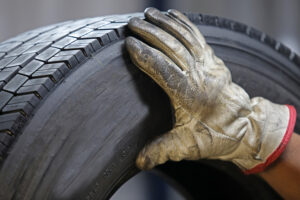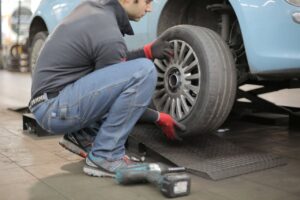What causes uneven tyre wear?
No matter how well you drive, your tyres will always gradually wear out as they run against the surface of the road. Whether it’s rough or smooth roads, the soft-ish rubber of the tyre is constantly being eroded, with the road surfaces tearing small parts of the rubber off of the tyres. Eventually, the tread will hit 3mm, which is the recommended tread depth you should allow your tyres to reach before changing them. When the tyres reach 3mm, they start to lose grip which causes safety issues, even before hitting the legal limit of 1.6mm. This wear of tyres is completely normal and they are designed to be regularly replaced.
What is uneven tyre wear?
Uneven tyre wear is when the tyre tread pattern wears away in a non-standard way. This is when the tread wears down one part of the tyre faster than the other which can cause issues with grip. This can lead to your tyres no longer being legal. Tyres should wear fairly evenly, so it is important to regularly check the tread carefully in order to consider why exactly they may be wearing unevenly.
What causes uneven tyre wear?
Uneven wear can be caused by a number of things, one of these being wheel alignment. If your wheels are misaligned, the uneven pressure the tyres have on the road will cause your tyre to wear in some places more than others. The wheel alignment could have been forced out of position by a road accident or kerb-mounting so if either of these has recently happened, you may need to conduct extra checks on your tyre treads to make sure they are wearing evenly.
Uneven wear can also be caused by some basic maintenance issues. These can include;
- The wrong tyre pressure – If your tyres are inflated to the wrong pressures, it will put different stresses on the surfaces of the tyres, causing the uneven wear.
- Suspension issues – If your shocks, springs or brushes, for example, are worn, it can put extra, unnecessary force onto your tyres, therefore affecting the wear.
- Faulty or excessive hard braking – The tyres can be unevenly worn if there has been excessive use of the brakes and the locking of wheels when driving at great speeds. This can wear them down to what is known as a worn flat tyre. The flat spots on your tyre can lead to the edges being unevenly worn every time the wheel revolves.
The different kinds of uneven tyre wear
Camber wear: The tyres edges, whether inside or outside, will wear far quicker than the rest of the tyre.
Feathered directional wear: The tread will feel smooth when rubbing your hand across it one way. However if rubbed the other way, it will feel rough to the touch.
Centre of the tread more worn than shoulders: The centre of the tyres will be more worn than the shoulders, usually due to tyre pressure issues.
Shoulders more worn than the centre: The edges wear far quicker than the centre of the tyre. This is usually caused by underinflated tyres.
How can you prevent uneven wear?
Like every aspect of your car, your tyres need to be regularly checked so you can stay on top of any issues or damages that could not only mount up to big repair costs but also lowers your risk of being involved in an accident. Tyre wear is normal, but if you notice they are wearing unevenly, these need to be checked by a specialist and changed at the first signs of the uneven tyre erosion. All tyres now have tyre-wear indicators. These are a series of lower sections on the tyre that are placed below the normal tread. These show you when your tyre is worn out as the surface of the road will erode the tyre down to them. Because these have been extended across the whole width of the tyre, it is easier for you to check for any irregular wear on your tyres.




